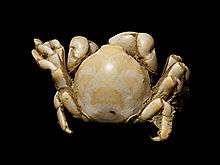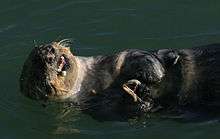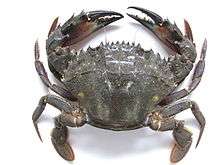Pinnotheridae
The Pinnotheridae are a family of tiny soft-bodied crabs that live commensally in the mantles of certain bivalve molluscs (and the occasional large gastropod mollusc species in genera such as Strombus and Haliotis). Tunicotheres moseri is commensal with a tunicate.[1] The earliest fossils attributable to the Pinnotheridae date from the Danian.[2]
| Pinnotheridae | |
|---|---|
 | |
| Pinnotheres pisum | |
| Scientific classification | |
| Kingdom: | |
| Phylum: | |
| Subphylum: | |
| Class: | |
| Order: | |
| Suborder: | |
| Infraorder: | |
| Superfamily: | Pinnotheroidea De Haan, 1833 |
| Family: | Pinnotheridae De Haan, 1833 |
| Genera and species | |
|
See text | |
Genera and species
This is a comprehensive list of species in the family, as of 2008:[3]
|
|
|
_above_the_plate_of_mussels_it_was_found_in.jpg)
A pea crab (exact genus and species unknown) above the plate of mussels it was found in

A yellow pea crab (exact genus and species unknown) has fallen out of the clam this sea otter is eating, and has landed on the sea otter's neck (in Moss Landing, California)
gollark: The issue is that calls have two ends, basically, and are nontransitive.
gollark: Again, not the problem.
gollark: Anyway, the issue isn't (right now) with those implementations, but the structure of calls.
gollark: Right now I have some highly inelegant caching.
gollark: Publish/subscribe.
External links
- Ambrosio, Louis J.; Baeza, J. Antonio (2016). "Territoriality and Conflict Avoidance Explain Asociality (Solitariness) of the Endosymbiotic Pea Crab Tunicotheres moseri". PLOS One. doi:10.1371/journal.pone.0148285. PMC 4766240.
- Andreas Brösing (2008). "A reconstruction of an evolutionary scenario for the Brachyura (Decapoda) in the context of the Cretaceous–Tertiary boundary" (PDF). Crustaceana. 81 (3): 271–287. CiteSeerX 10.1.1.652.1701. doi:10.1163/156854008783564091.
- P. K. L. Ng, D. Guinot & P. J. F. Davie (2008). "Systema Brachyurorum: Part I. An annotated checklist of extant Brachyuran crabs of the world" (PDF). Raffles Bulletin of Zoology. 17: 1–286.
This article is issued from Wikipedia. The text is licensed under Creative Commons - Attribution - Sharealike. Additional terms may apply for the media files.
